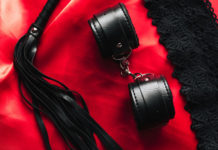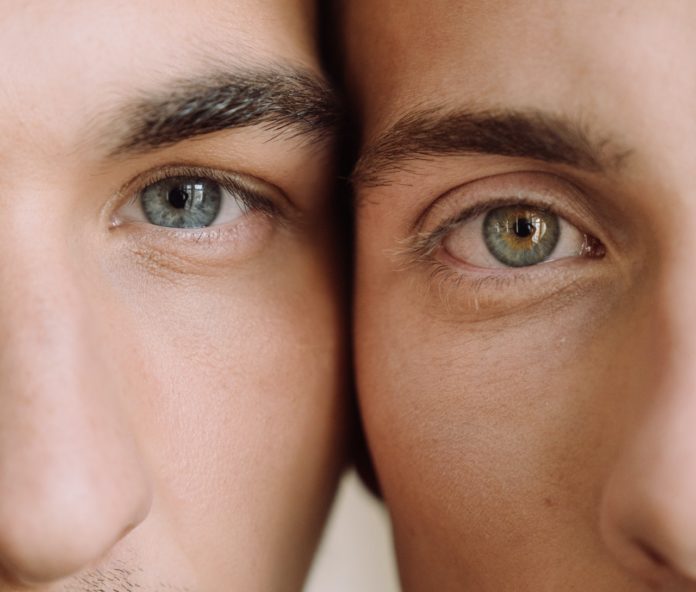In Your Eyes: Love at First Sight
There’s an incredibly visceral connection between touch and sight. When we see something we like, we are drawn to feel it. I compare vision to pop music. It’s colorful, bright, emotional, and universal.
Humans are highly visual animals and there’s nothing quite like the feelings generated by the things we see. What can compare to a glorious sunset, the extraordinary sight of a long lost friend, or the first time you see your new lover smile?
And who isn’t familiar with the phrase “love at first sight”? This romantic concept has inspired countless songs, poems, movies and embarrassing text messages and Facebook posts.
The phenomenon may actually have a basis in science. The findings of several studies
have shown that more men have proven to believe in the concept of love at first sight than women. This is largely because men respond to physical attributes more quickly than women and women also take longer to settle into a feeling of trust.
Considered to be the most complex sense, vision is an intricate process of data being transferred from the optical nerves to the various parts of the brain responsible for naming things, remembering faces and places, and the emotional reactions to what is being seen. The brain combines the messages from both eyes in order to create a single three-dimensional image. To complicate things further, the image received on the retina is upside down due to the focusing action of the lens and the brain has to flip the image to provide the right-side-up view.
Sight is such an integral part of the human experience that nearly 50% of the brain’s sensory resources are dedicated to vision, according to Dr. John Medina, developmental molecular biologist and best- selling author of Brain Rules. That means that vision alone uses as much of the brain as all the other senses combined.
In a relationship, it’s important to make a concerted effort to not just look, but to see. This is especially important for those in long-term relationships. The longer we spend with people, the more easily we forget to pay attention to the details. It is quite possible to become unaware of something one sees every day. That’s one of the great capacities of the brain.
“It’s not what you look at that matters, it’s what you see.” – Henry David Thoreau
Can you easily move through your home in the dark because you know where everything is without needing to constantly see it? The same thing can happen with the people around us. We forget to look at them because we know what they look like but, in reality,
the image we have in our head is purely a memory unless we take the time to fully focus and look. This phenomenon explains why a haircut, weight loss, or a new shirt might be missed. Even though we are side by side, unless we turn to really look, the person we see in our peripheral vision is only the “photograph” we have from the last time we paid attention.
NEURO-CISE: VISUAL, DUO
Romance and love are richly enhanced by the sense of sight. If you invest time, energy and focus into the visual aspects of your relationship, you will absolutely create a stronger bond.
Some easy ways to do this include:
♥ Send your partner an email or text message photo of your smiling face.
♥ Wear a small surprise that you can secretly reveal in public, like a temporary tattoo of your partner’s nickname. It doesn’t have to be naughty, just meaningful.
♥ Undress for your partner, slowly and seductively.
♥ Make love with a commitment to eye contact.
♥ Dim the lights or use colored fabric to drape over lampshades, candles, wear lingerie or pose in front of a mirror, tidy up your place, pretend a VIP is coming to visit, turn your bedroom into a romantic boudoir.
The importance of vision in romantic connection helps explain the popularity of romantic movies. Do you have a favorite movie that you turn to when you need to feel ‘“in the mood” or one that reminds you of the romance in the world when you’re having a blue day?
Get into character and reenact your favorite love scenes from movies.
A few notable films to check out for this are: Body Heat, A Walk On the Moon, Before Sunset, Bull Durham, Shortbus, The Pornographer, Intimacy, Brokeback Mountain, 9 1/2 Weeks, and In the Realm of the Senses.
Reenact your favorite kissing scenes from movies with your partner.
Whether it’s from Pirates of the Caribbean, Closer, Twilight, The Notebook, Mulholland Drive, or A Single Man, this could be the perfect way to create a kissing sensation that surpasses your expectations.
Pretend that you are the writer, director, and star of a hot steamy movie and your partner is your co-star. Give him or her a kissing scene to perform on you.
Hollywood may give us false hope for “happily ever after” but it also reminds us that love is a complicated, funny, challenging, scary, exciting adventure. Are you living the kind of the love that could ignite the silver screen?
Seeing What The Body Says
If you’ve heard that 55% of communication is based on non-verbal body language, 38% is all about the tone of voice and only 7% is based on actual words spoken, then you are familiar with researcher Professor Albert Mehrabian whose findings are quoted worldwide,
and have become known as the 7%-38%-55% rule. So it’s incredibly important to remain aware of eye contact, facial expressions and posture, especially during intimate discussions.
Speaking of eye contact, according to Joe Riggs, acclaimed mentalist, hypnotherapist and author, it’s actually possible to watch a person’s eyes alone as an indication of whether or not they are telling the truth. “When asking someone a direct question, a left or right eye
movement can mean the difference between the truth and a lie. Looking to the left indicates a made up answer as their eyes are showing a constructed image or sound whereas looking to the right would indicate a “remembered” voice or image, and thus would be the truth. Remember that every person is different so never base a conclusion on just one observation.”
Have you ever paid attention to the body language of other people when you have an opportunity for observation? The next time you are in a restaurant, a park or other social environment, take a moment to look at how other people are interacting. Without hearing any words, how much information can you decipher? The man with his arms crossed while his female companion speaks – is he disinterested or is he angry? The girl leaning forward with a smile as she orders coffee from the boy looking away – is she flirting and, if so, is he interested?
If you’d like to improve the way you use body language in your own life, mentally, physically and emotionally, you can simply be aware of your posture by standing up straight and boldly putting your hands on your hips in order for your brain to increase 20% testosterone and decrease 25% cortisol, according to a study by social psychologist Amy Cuddy at Harvard.
“Looking down when you’re talking to someone is a dead giveaway of insecurity.”- Sharon Sayler
NEURO-CISE: VISUAL, SOLO
♥ A smile is an open door of approval and if you keep a consistent gaze with the person you are talking to at the same time, you’ve got a sensory visual connection.
♥ Relax your shoulders and have your palms facing upwards with your fingers facing the person you are talking to, as open hand gestures signify that you are open to exchanging ideas with them.
♥ Point your feet towards the person you are interested in and see if their feet are pointed towards you, which is a good sign and means they want you to approach them.
♥ Lean in to conversations and nod when you agree with something being said, so that you both feel like you are on the same page.
♥ Don’t hold anything in front of your chest. Covering your heart creates a guarded perception.
♥ As a couple, when you both mimic each other’s moves on the dance floor or order the same drinks, you clearly are in sync mentally, physically and emotionally.
The bottom line is that if you’re not feeling confident, then fake it until you make it and turn your happy button on, as your brain won’t know the difference between what is real and what is imagined.






























[…] post Sensation Play: The Eye of the Beholder appeared first on […]